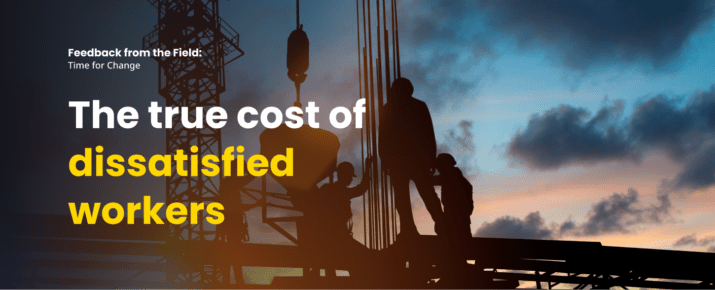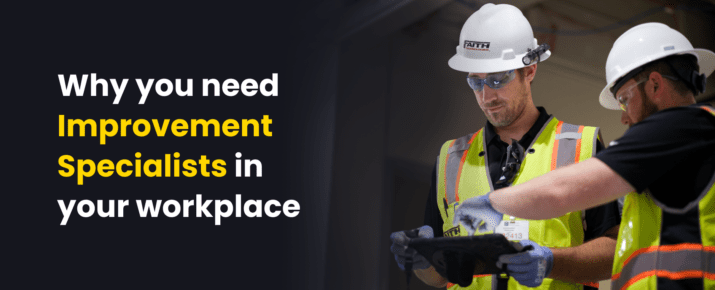Top reasons workers are cutting corners with health and safety at work
World Of Work | By | 7 Jun 2024 | 5 minute read

It’s no secret that frontline workers operate in a high-stakes environment. We often talk about the risks of this line of work – from the physical demands of the job to its susceptibility to accidents and injury. Safety awareness should be paramount, but our latest research has revealed workers are still driven to cut corners.
We recently surveyed over 1,200 workers in the UK across various frontline industries, including construction, healthcare, hospitality, logistics and transportation, manufacturing, and retail.
Our research found that:
- 45% of UK frontline workers are worried about safety at work
- 37% of UK frontline workers have risked their own health and safety at work.
Evidently, more needs to be done. While many workplaces are getting better at identifying individual hazards and dealing with them, we haven’t been stepping back to examine the bigger picture.
As a result, frontline workers continue to shoulder enormous pressure and take on unnecessary risks. Now is the time for health and safety professionals to tackle the challenges of frontline work head-on. If workers are cutting corners, we need to ask ourselves why.
Why are frontline workers cutting corners and what can we do about it?
It seems that workers, in their efforts to do their best work and meet expectations, are putting themselves at risk. But it doesn’t have to be that way.
Let’s take a closer look at the most pressing concerns for frontline workers and the practical steps health and safety professionals can take to address them.
1. Demand and supply
Frontline workers are being pushed to the breaking point, with more than half citing pressure to meet deadlines (59%) and staff shortages (51%) as reasons why they cut corners in the workplace. The lack of proper equipment (44%) also factors into the pressure cooker environment, as teams on the ground are tasked with doing more with less.


What can H&S professionals do?
Increasing demands for efficiency is simply the reality of work today, so explore ways to free up time for frontline teams. Don’t be afraid to lean on technology here. 46% of frontline workers said a lack of innovation and new technology sometimes get in the way of productivity, with the highest percentage coming from newer entrants to the workforce (18-24 year olds).
Secure the future of the frontline and streamline safety procedures with digital inspections workers can deploy on the go. Go one step further and use the data captured to gain visibility across your operations, pinpoint trends, and redistribute workloads accordingly.
Reduce downtime with sensors to contactlessly monitor conditions in real-time. The technology can keep track of ambient conditions and potential hazards and even be used as a preventative system.

2. Extreme weather
Four of the top five disruptions to the UK’s frontline workforce in the past 12 months were weather-related, with hot temperatures, icy weather, floods, and storms all preventing staff from doing their jobs.
As a result, nearly half (47%) of workers said they arrived late, and nearly a fifth (16%) were unable to leave home at some point last year due to these disruptions, meaning they couldn’t do their job at all. With teams already stretched thin, it’s no wonder these disruptions have serious knock-on effects.
What can H&S professionals do?
Tackling the effects of climate change can be daunting, but it should be top of mind for companies. In fact, it was even the focus of this year’s World Day for Safety and Health at Work.
Look into employee wellness programs and encourage open lines of communication to see how you can best support your teams. From providing sufficient protective gear to installing cooling systems in hot environments, it falls on employers to ensure their workers are well-equipped to perform their duties safely.
3. Team communication
Communication is the key to success (and safety) in the workplace. But you can’t use a one-size fits all approach when it comes to a dispersed workforce.
Our study found that 38% of frontline workers agreed poor communication in teams often gets in the way of productivity. We also found the highest levels of agreement among those aged between 18 and 44.
What can H&S professionals do?
Employers need to balance connecting with a tech-savvy, younger workforce and not leaving behind the more experienced generations.
Start by segmenting message recipients to specific teams to cut down on the noise and ensure team members are only receiving content relevant to them. Try creating content that teams actually want to read by using a medium loved by all – rich media. And make sure to leave avenues for feedback and engagement from staff.
P.S. You can do all of that – and more – with a Heads Up.
What is Heads Up? Heads Up is a tool that allows easy and efficient communication between teams. Team leaders can instantly send quick-fire messages (e.g., video, images, or PDFs) to their network of employees—no matter where they are. With Heads Up, you can see who has acknowledged the message, send custom messages for specific teams, and schedule messages.
4. Learning and development
Here’s the thing: workers want to be good at their jobs. They’re eager to upskill and succeed in their roles. Unfortunately, this is an area where many companies often fall short.
More than a fifth of workers said lack of skills, development, and training often get in the way of productivity and slows them down at work (21%). Demand for more training was highest in the 25-34 age bracket (26%), where workers are in the early to mid-stage of advancing their careers.
What can H&S professionals do?
The world of work is a space of rapid change, with advancing technologies, new regulations, and evolving priorities. Start by reviewing your current training material. Don’t settle for a ‘set and forget’ practice. You should review your offerings every six months to a year to ensure they’re still relevant and helpful.
Training on the SafetyCulture platform is easy to access on any device and can be translated into different languages for diverse workforces. With quick bite-sized courses, learning and development opportunities can easily fit into the flow of frontline work, rather than disrupting it.


Closing the loop
The tides are turning on attitudes towards safety, with 65% of people surveyed citing they care a lot about their personal health and safety.
This is also reflected in feelings toward health and safety professionals. Almost half (48%) found H&S roles necessary, and a quarter (25%) noted they’re important for driving workplace improvements.
It’s clear there’s a shared willingness to improve health and safety outcomes for everyone involved. We’ve got some great insights from the frontline, but remember, your teams will have ones of their own – make sure you’re listening! After all, they are the ones best equipped to alert you to areas of concern.
The best way to do this is through a dedicated reporting process or platform. With SafetyCulture, teams can raise issues and assign actions directly within the platform, so management can ensure things get resolved.
Close collaboration between management and the frontline is key to unlocking change – so let’s roll up our sleeves and get to it!
About the research
All figures are from Obsurvant. Total sample size was 1,219. Fieldwork was undertaken between 3rd-9th April 2024. The survey was carried out online. Frontline workers are defined as individuals aged 18-64 in the UK who must physically show up to their role. Respondents were all in full-time employment. The sectors which respondents worked in were: construction, healthcare, hospitality, logistics, manufacturing, and retail.
Read more insights on the world of work:
- How to prioritize the safety of your outdoor workers
- Top environmental, health and safety (EHS) trends for 2024
- Frontline workers want flexibility too – here’s how to get it right
Important Notice
The information contained in this article is general in nature and you should consider whether the information is appropriate to your specific needs. Legal and other matters referred to in this article are based on our interpretation of laws existing at the time and should not be relied on in place of professional advice. We are not responsible for the content of any site owned by a third party that may be linked to this article. SafetyCulture disclaims all liability (except for any liability which by law cannot be excluded) for any error, inaccuracy, or omission from the information contained in this article, any site linked to this article, and any loss or damage suffered by any person directly or indirectly through relying on this information.





